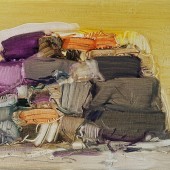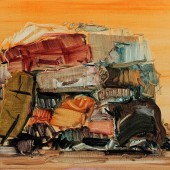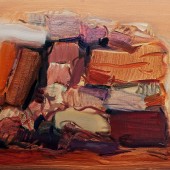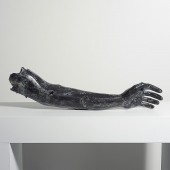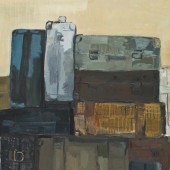Mohamad Said Baalbaki
Themes of historical accuracy, institutional power and social memory feature in the artwork of painter and interdisciplinary artist Mohamad Said Baalbaki.
Based in Berlin, the Lebanese artist was initially known for painted works that drew on his experiences as a child during the Lebanese Civil War and Israeli occupation. Baalbaki and his family were often uprooted and forced to move between different districts in Beirut and elsewhere in Lebanon during the war. Baalbaki’s paintings, often devoid of people, portray piles of items such as suitcases, shoes, clothing and other belongings, symbolising lost, unrecorded and forgotten stories of history. A conceptual shift in Baalbaki’s work occurred in 2006 when he began to examine the role of museums and institutions in guiding dominant perceptions of history. His ongoing project “Al Buraq” is a fictional museum display charting the discovery of remains of the winged horse with a human head that is part of the Islamic tradition. Baalbaki seeks to challenge the credibility of the museum, asking: “why and how does an artefact presented in a museum convey the impression of utmost credibility and authenticity to the spectator?” Baalbaki’s work, featured in many prestigious galleries, has been exhibited across the Middle East, Europe, Canada and the United States.
Related artists by country
- Akram Zaatari
- Camille Zakharia
- Fouad Elkoury
- Chafic Abboud
- Nabil Nahas
- Rim Al Jundi
- Shawki Youssef
- Tagreed Darghouth
- Zena Assi
- Zena Al Khalil
- Joana Hadjithomas and Khalil Joreige
- Samir Sayegh
- Elie Kanaan
- Emmanuel Guiragossian
- Fadia Haddad
- Saliba Douaihy
- Ziad Antar
- Ali Cherri
- Inaya Fanis Hodeib
- Walid Raad
- Charbel-joseph H. Boutros
- Hussein Madi
- Lamia Joreige
- Marwa Arsanios
- Huguette Caland
- Michel Basbous
- Khalil Gibran
- Bibi Zogbe
- Etel Adnan
- Saloua Raouda Choucair
- Aref El Rayess
- Yvette Achkar
- Ali Rafei
- Habib Srour
- Chaouki Choukini
- Helen Khal
- Omar Onsi
- Rafic Charaf
- Seta Manoukian
- Juliana Seraphim
- Afaf Zurayk
- Nadia Saikali
- Deirrieh Fakhoury
- Abdul Hamid Baalbaki
- Laure Ghorayeb
- Nabil Kanso
- Odile Mazloum
- Stephanie Saade
- Douglas Abdell
- Dalia Baassiri
- Samia Osseiran Joumblatt
- Serge Najjar
- Habuba Farah
- Moazaz Rawda
- Lara Baladi
- Joana Hadjithomas & Khalil Joreige
- Mona Hatoum
- Alfred Tarazi
- Fouad El Khoury
